It's been a long time since I wrote this article, but the fact remains: The good old eMac can still be useful if you take the simple steps to keep it as good as it can be. All can run Tiger, and most can run Leopard - great operating systems for their day with a bit of useful life. This article describes the procedure I used to upgrade my old eMac, including:
Upgrading versus Replacing
 My sister's eMac is of the 700 mhz variety, with 256 MB of memory. The machine seemed to be getting "slower", and the original 40 GB disk was becoming jammed packed with photos and iTunes, and within a few months she'd be out of disk space.
My sister's eMac is of the 700 mhz variety, with 256 MB of memory. The machine seemed to be getting "slower", and the original 40 GB disk was becoming jammed packed with photos and iTunes, and within a few months she'd be out of disk space.
There were two options to address the problems: upgrade the eMac, or go out and buy a new Mac.
I decided to keep the eMac. It has been a rock solid machine, and it is only used for typical applications like NeoOffice, email, Safari, iTunes, and kids games. By upgrading the hard drive, the memory, and the OS, I could give it several more years of useful life.
Hard Drive Upgrade: the plan
My strategy to upgrade the hard drive was to
Buying a new drive & the need for a firewire enclosure
After research, it seems that all eMac models can use just about any large, modern 3.5" ATA (but not SATA) hard drive. I went with a Hitachi 3.5", 160 GB drive from Best Buy ($40 after rebate). A nice, even more impressive alternative is the inexpensive Western Digital 500 GB Caviar Blue.
My plan was to copy the entire content of the existing eMac onto the new drive. Such a copy can save a lot of time reinstalling and reconfiguring software. The fastest and easiest way to make the hard drive copy was to temporarily attach the new drive to the eMac with a Firewire enclosure.
A firewire enclosure is a small case built to house a single IDE drive. The case has an IDE-to-Firewire converter on board, as well as a small power supply to spin the drive. Therefore, this enclosure allows a computer to mount an IDE drive over firewire.
I can't say enough about the usefulness of a Firewire enclosure - it is a great tool for both Mac and PC upgrade and backup work, and the enclosures are very inexpensive (you can find them for under $50 from several vendors). I recommend getting an enclosure with the following attributes:
 looks great, has excellent features, and is inexpensive too.
looks great, has excellent features, and is inexpensive too.
Installing an IDE drive into the firewire enclosure was simple: Attach the IDE ribbon cable hanging off of the enclosure to the drive, plug the power connector on the enclosure into the drive, and attach the enclose to the eMac via a Firewire cable.
Disk partitioningSince the Hitachi drive was new, I needed to create a Mac-compatible partition on the drive. I ran the MacOS utility program "Disk Utility", which clearly listed the new disk on the left pane. I selected the new drive and clicked on the "Partition" tab. I formatted the 160 GB disk as a single partition of type "Mac OS Extended (Journaled)". After partitioning, the new disk was visible on my desktop. Yay!
Hard Disk Cloning
I needed to copy everything on the internal eMac hard disk to the external drive. I used the free program "Carbon Copy Cloner" to make the copy. This little gem of a program smartly copies an entire drive's contents to another drive. I told CCC to clone the eMac's internal disk to the new drive over firewire. Without much fanfare, CCC did it's thing and copied the contents.
Now let me warn you - copying 38 GB of data from the eMac to the new drive took over 60 minutes.
Testing the Clone
After CCC was done with the cloning process, I wanted to test the clone. What if the clone didn't really work? Then I'd have to install all that software manually. Yuk!
Happily, I learned that I could coerce an eMac to boot from a firewire device (but not a USB drive).
With the firewire enclosure attached, I restarted the eMac and held down four keys during the startup process: "Command-Option-Shift-Delete". This sequence tells the Mac to boot from a device other than the standard start-up drive. Within 30 seconds the Mac successfully booted from the cloned drive. From there I was able to run the eMac off of the new (but externally-housed) drive, giving me a chance to make sure that the clone was 100% successful. Now I was ready to surgically swap the drives!
Installing the new Hard Disk
The final step - and the big one - was to remove the old 40 GB drive and replace it with my new 160 GB drive. I removed the new drive from the Firewire enclosure, took a deep breath, and commenced eMac disassembly.
Taking the eMac apart isn't difficult. I used Apple's eMac Take Apart manual as a reference.
Here's the order of events, with my additional suggestions in red:
After this process, I'm pretty comfortable working on the inside of an eMac. It isn't as easy as working on a motherboard in an ATX case, but it's much easier than working on the inside of any laptop.
Memory Upgrade
The easiest thing you can do with an eMac is upgrade it's memory. The 700 MHz eMac uses common "PC133" or "PC100" memory modules. I bought a 512 MB memory module for the eMac from MacSales.Com. The module cost about $75. Shop around - memory prices are always changing.
To install the memory, I opened up the eMac's memory access bay on the bottom of the machine by removing the single screw. I then removed the one of the two memory modules in the eMac and replaced it with the new 512 MB module.
I wrapped things back up and booted the eMac. I went to "About This Mac", and saw that the Mac was happy with 640 MB (512 MB + 128 MB). [These days, I recommend you get two 512 MB modules, bringing the Mac up to a full 1 GB of memory]
In the past we had problems opening more than two applications at once - but with the new memory I was able to open 5 or 6 applications, all with great performance.
Upgrading to the OS
The eMac was running "Jaguar", OS X v10.2 - a reliable version of Mac OS X. But Tiger (OS X v10.4) is a substantial improvement. Those with a faster eMac (> 867 Mhz) may want to upgrade to Leopard.
It was a no-brainer to upgrade the OS, and upgrading is easy if your eMac has a DVD drive (and if you don't have a DVD drive, read my comments on Firewire enclosures, above).
The upgrade to Tiger was a simple exercise of inserting the Tiger DVD into the DVD drive and clicking through the menus. The upgrade process retained all of the eMac's user accounts, data, and applications, so I experienced no loss of any data or programs.
When the upgrade completed I rebooted the machine and performed a "software update" to patch Tiger from version 10.4 to the latest patch release [10.4.4 as of 12-Jan-06].
The entire Tiger upgrade took about 70 minutes to install, and had no negative consequences.
Leftover Parts
I'm happy to say that I didn't have any leftover screws. However, I did have some parts:
In all, the eMac now rocks - although it still only runs at 700 MHz, the addition of 512 MB of memory, an upgraded OS, and a larger hard drive significantly improves performance.
Buying components for the eMac is very easy. Memory, hard drives, and Firewire enclosures are readily available from many vendors at low cost.
- Replacing the internal hard disk with a large capacity drive.
- Increasing the memory for performance
- Upgrading the operating system
Upgrading versus Replacing
 My sister's eMac is of the 700 mhz variety, with 256 MB of memory. The machine seemed to be getting "slower", and the original 40 GB disk was becoming jammed packed with photos and iTunes, and within a few months she'd be out of disk space.
My sister's eMac is of the 700 mhz variety, with 256 MB of memory. The machine seemed to be getting "slower", and the original 40 GB disk was becoming jammed packed with photos and iTunes, and within a few months she'd be out of disk space.There were two options to address the problems: upgrade the eMac, or go out and buy a new Mac.
I decided to keep the eMac. It has been a rock solid machine, and it is only used for typical applications like NeoOffice, email, Safari, iTunes, and kids games. By upgrading the hard drive, the memory, and the OS, I could give it several more years of useful life.
Hard Drive Upgrade: the plan
My strategy to upgrade the hard drive was to
- Clone the internal hard disk onto a new drive mounted in a firewire enclosure.
- Test the clone by booting from the new drive mounted in the firewire enclosure.
- Surgically replace the eMac's internal hard drive
Buying a new drive & the need for a firewire enclosure
After research, it seems that all eMac models can use just about any large, modern 3.5" ATA (but not SATA) hard drive. I went with a Hitachi 3.5", 160 GB drive from Best Buy ($40 after rebate). A nice, even more impressive alternative is the inexpensive Western Digital 500 GB Caviar Blue.
My plan was to copy the entire content of the existing eMac onto the new drive. Such a copy can save a lot of time reinstalling and reconfiguring software. The fastest and easiest way to make the hard drive copy was to temporarily attach the new drive to the eMac with a Firewire enclosure.
A firewire enclosure is a small case built to house a single IDE drive. The case has an IDE-to-Firewire converter on board, as well as a small power supply to spin the drive. Therefore, this enclosure allows a computer to mount an IDE drive over firewire.
I can't say enough about the usefulness of a Firewire enclosure - it is a great tool for both Mac and PC upgrade and backup work, and the enclosures are very inexpensive (you can find them for under $50 from several vendors). I recommend getting an enclosure with the following attributes:
- 5.25" (large) drive support, so that you can throw anything into the enclosure, from a 2" IDE laptop hard drive to a DVD burner.
- Dual Firewire & USB2 support, so you have the maximum amount of connectivity flexibility.
Installing an IDE drive into the firewire enclosure was simple: Attach the IDE ribbon cable hanging off of the enclosure to the drive, plug the power connector on the enclosure into the drive, and attach the enclose to the eMac via a Firewire cable.
Disk partitioningSince the Hitachi drive was new, I needed to create a Mac-compatible partition on the drive. I ran the MacOS utility program "Disk Utility", which clearly listed the new disk on the left pane. I selected the new drive and clicked on the "Partition" tab. I formatted the 160 GB disk as a single partition of type "Mac OS Extended (Journaled)". After partitioning, the new disk was visible on my desktop. Yay!
Hard Disk Cloning
I needed to copy everything on the internal eMac hard disk to the external drive. I used the free program "Carbon Copy Cloner" to make the copy. This little gem of a program smartly copies an entire drive's contents to another drive. I told CCC to clone the eMac's internal disk to the new drive over firewire. Without much fanfare, CCC did it's thing and copied the contents.
Now let me warn you - copying 38 GB of data from the eMac to the new drive took over 60 minutes.
Testing the Clone
After CCC was done with the cloning process, I wanted to test the clone. What if the clone didn't really work? Then I'd have to install all that software manually. Yuk!
Happily, I learned that I could coerce an eMac to boot from a firewire device (but not a USB drive).
With the firewire enclosure attached, I restarted the eMac and held down four keys during the startup process: "Command-Option-Shift-Delete". This sequence tells the Mac to boot from a device other than the standard start-up drive. Within 30 seconds the Mac successfully booted from the cloned drive. From there I was able to run the eMac off of the new (but externally-housed) drive, giving me a chance to make sure that the clone was 100% successful. Now I was ready to surgically swap the drives!
Installing the new Hard Disk
The final step - and the big one - was to remove the old 40 GB drive and replace it with my new 160 GB drive. I removed the new drive from the Firewire enclosure, took a deep breath, and commenced eMac disassembly.
Taking the eMac apart isn't difficult. I used Apple's eMac Take Apart manual as a reference.
Here's the order of events, with my additional suggestions in red:
- Remove the Airport card if you have it. (I found after I started case disassembly that it is easier if you remove this card first.)
- Disconnect the eMac from all cables. Place the eMac on it's "face"
- Remove the memory access panel
- Unscrew the case back, and lift it up only about an inch.
- Unplug the wire from the power switch mounted on the case. This was tricky - I used small needle nosed pliers to disconnect (and reconnect) the wire from the switch.
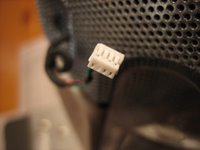
- Lift off the case once the power connector is detached from the power switch
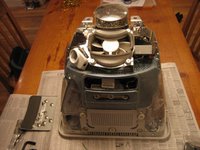
- Discharge the CRT. Some claim that this is an optional step, but I did it anyway, because I didn't want to get a shock. I built a discharge tool using a screw driver and a length of wire connected to the eMac's metal frame. Without touching anything other than the insulated screwdriver handle, I gently slid the screwdriver tip under the CRT's "suction cup" until I touched the metal conductor under the cap. Also see a very informative Mac CRT discharge diagram here.
- Remove the fan (5 screws, two connectors, one ground wire)
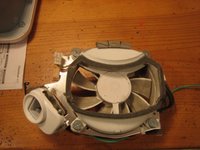
- Remove the speaker unit (one connector)
- Remove the shielding (five screws)
- Remove the logic board subsystem (9 screws, one video connector)
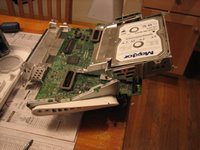
- Remove the old drive
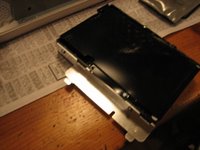
- Remove the drive insulators/pads/bracket from the old drive. Unlike the photos in the take apart manual, my original drive only had a one pad, which was mounted on the edge of the drive.
- Install drive insulator/pads/bracket onto new drive
- Connect the ribbon cable and the 4-pin power cable to new drive. Lessons Learned: Make sure the IDE connector is properly seated on the motherboard! Make sure new drive is jumpered for "Cable Select" mode!
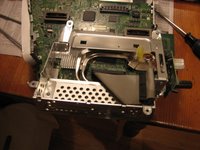
- Attach the drive onto it's carrier
- Install the logic board subsystem.
- Lesson Learned: re-install the airport card now (I recommend re-installing it here to ensure that the logic board is properly aligned with the case)
- Reinstall remaining components in opposite order of removal.
After this process, I'm pretty comfortable working on the inside of an eMac. It isn't as easy as working on a motherboard in an ATX case, but it's much easier than working on the inside of any laptop.
Memory Upgrade
The easiest thing you can do with an eMac is upgrade it's memory. The 700 MHz eMac uses common "PC133" or "PC100" memory modules. I bought a 512 MB memory module for the eMac from MacSales.Com. The module cost about $75. Shop around - memory prices are always changing.
To install the memory, I opened up the eMac's memory access bay on the bottom of the machine by removing the single screw. I then removed the one of the two memory modules in the eMac and replaced it with the new 512 MB module.
I wrapped things back up and booted the eMac. I went to "About This Mac", and saw that the Mac was happy with 640 MB (512 MB + 128 MB). [These days, I recommend you get two 512 MB modules, bringing the Mac up to a full 1 GB of memory]
In the past we had problems opening more than two applications at once - but with the new memory I was able to open 5 or 6 applications, all with great performance.
Upgrading to the OS
The eMac was running "Jaguar", OS X v10.2 - a reliable version of Mac OS X. But Tiger (OS X v10.4) is a substantial improvement. Those with a faster eMac (> 867 Mhz) may want to upgrade to Leopard.
It was a no-brainer to upgrade the OS, and upgrading is easy if your eMac has a DVD drive (and if you don't have a DVD drive, read my comments on Firewire enclosures, above).
The upgrade to Tiger was a simple exercise of inserting the Tiger DVD into the DVD drive and clicking through the menus. The upgrade process retained all of the eMac's user accounts, data, and applications, so I experienced no loss of any data or programs.
When the upgrade completed I rebooted the machine and performed a "software update" to patch Tiger from version 10.4 to the latest patch release [10.4.4 as of 12-Jan-06].
The entire Tiger upgrade took about 70 minutes to install, and had no negative consequences.
Leftover Parts
I'm happy to say that I didn't have any leftover screws. However, I did have some parts:
- One 128 MB memory module. This is now installed in my father's clunker PC. Yep, this old eMac memory is 100% compatible with my Dad's Windows-based PC.
- One 40 GB IDE drive. I'm going to keep this around for a while until the 160 GB drive has been running for a few months. After that, the 40 GB drive will land in my dad's PC.
In all, the eMac now rocks - although it still only runs at 700 MHz, the addition of 512 MB of memory, an upgraded OS, and a larger hard drive significantly improves performance.
Buying components for the eMac is very easy. Memory, hard drives, and Firewire enclosures are readily available from many vendors at low cost.







